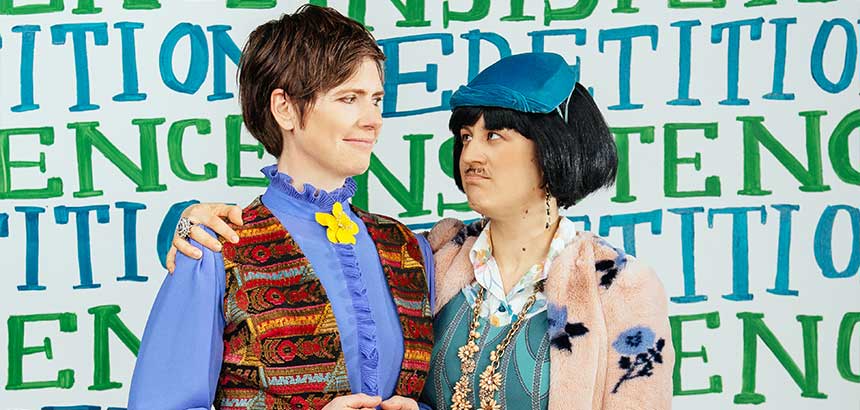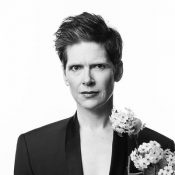“Is there repetition, or is there insistence?
I am inclined to believe there is no such thing as repetition.”
– Gertrude Stein
When we began to talk about bringing Gertrude and Alice back to the Buddies stage, I felt it was an opportunity – a rare and wonderful opportunity – to continue the creative process, rather than simply reproduce what had been done the last time.
Inspired by Gertrude’s artistic commitment to contemporaneity and her emphatic insistence on art as an expression of the present and the future, for this new production we invited contemporary artist Sherri Hay to interpret the physical, visual world of the play from a new point of view.
Gertrude Stein and her wife Alice B Toklas were Americans living in Paris in the early 20th century who became influential figures in the birth of modernism. Their collection of modern art – early works of many painters including Picasso, Matisse and Gauguin, who were to become the defining artists of their generation – was what first made Gertrude and Alice famous as tastemakers at the centre of an avant garde art. But Gertrude was also a prolific writer, obsessed with capturing the essence of the rapidly changing times she lived in through words and formal literary experiment. Influenced by the paintings and painters she loved, she strove to do the same thing with language and literature.
The play is set in “the continuous present”, a concept that Gertrude wrote and spoke about extensively in relationship to the creative /artistic process. Gertrude also famously referred to plays as “landscapes”. It seemed only fitting that the design of this play – a meditation on art, time, love and influence – should be put into the hands of a wildly original, contemporary artist of our own time.
Hay’s design concept, inspired both by Stein and Hay’s own current explorations of the relationship between objects, movement and time, immediately brought new and exciting dimensions to the play text, adding another layer of visual meaning to the work.
Hay’s set design is a striking work of art, a three-dimensional, moving sculpture inspired by some early Picasso sketches. At the time of writing this, we are deep in rehearsal, creating our new staging as the characters respond to the physical playground Hay has created, discovering new levels of metaphor, meaning and “play” within the play.
In addition to Hay’s production design, director Karin Randoja has composed a brilliant new score for the play, working with sound designer Aleda Deroche. We can’t wait to meet the audience inside the new space of this production, and whether you are seeing it again, or for the first time, we hope you will agree with us that Gertrude and Alice is a theatre experience that bears repeating.
ABOUT SHERRI HAY:
Sherri Hay a Canadian artist who splits her time between NYC and Toronto. With a wide-ranging practice that includes sculpture, installation, video and performance, her work has been exhibited internationally, including the Art Gallery of Toronto, and the Museum of Canadian Contemporary Art in Toronto. Since 2012, her practice has focused on movement and time, relationships and change, exploring the quality and the extent to which she can give over voice as an artist – how she can be the instigator of a process instead of the Creator-from-nothing, proposing a certain kind of sentience for objects as performers.
In an artist statement about her work, Sherri says:
“My work focuses on movement and time, relationships and change. It asks questions about our relationship with the objects around us. For so much of our European history, what has been valorized was the human who would subdue and shape the world through his reason and will, a world that was considered to be inert and insensible. Nevertheless, as a sculptor, it has never seemed outlandish to me to think about objects as having a life of their own. The anthropologist Nurit Bird-David describes a kind of empathetic understanding between people and the things around them that is bred by familiarity.
An artist friend from Japan tells how seamstresses hold funerals for their needles by burying them in a soft block of tofu at the temple. At first, perhaps this sounds odd. But really we are every day more familiar with how our smart devices seduce us and become our closest relationships. In this new age of connectivity, some new ways of being and relating are coming into focus, beginning to acknowledge to a broad spectrum of otherness beyond the merely human.
Recently, the objects I have been making have been performing very slowly. Time is somehow related to movement, and watching a slow moving object for a long time makes a human watching it very aware of time.
But by time, I’m beginning to think I really mean presence: that is this slowness means spending some time attending to the present in a way that we don’t usually do in our day to day lives.”
cuttsgallery.com/artists/sherri-hay/


